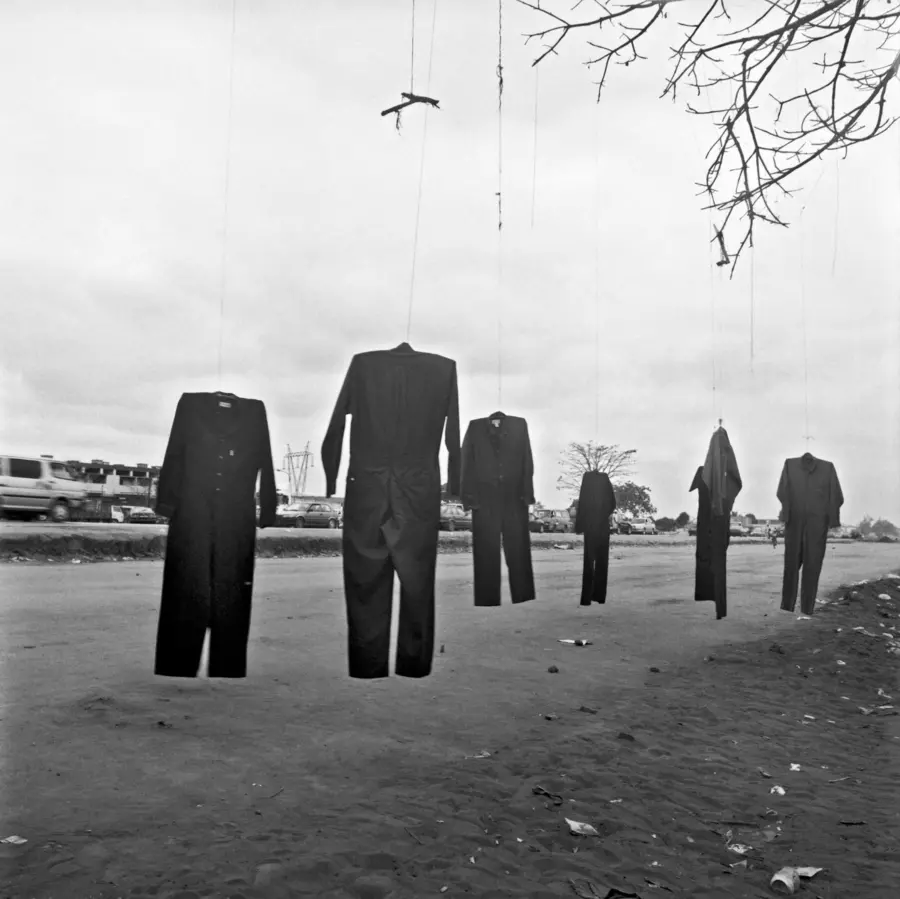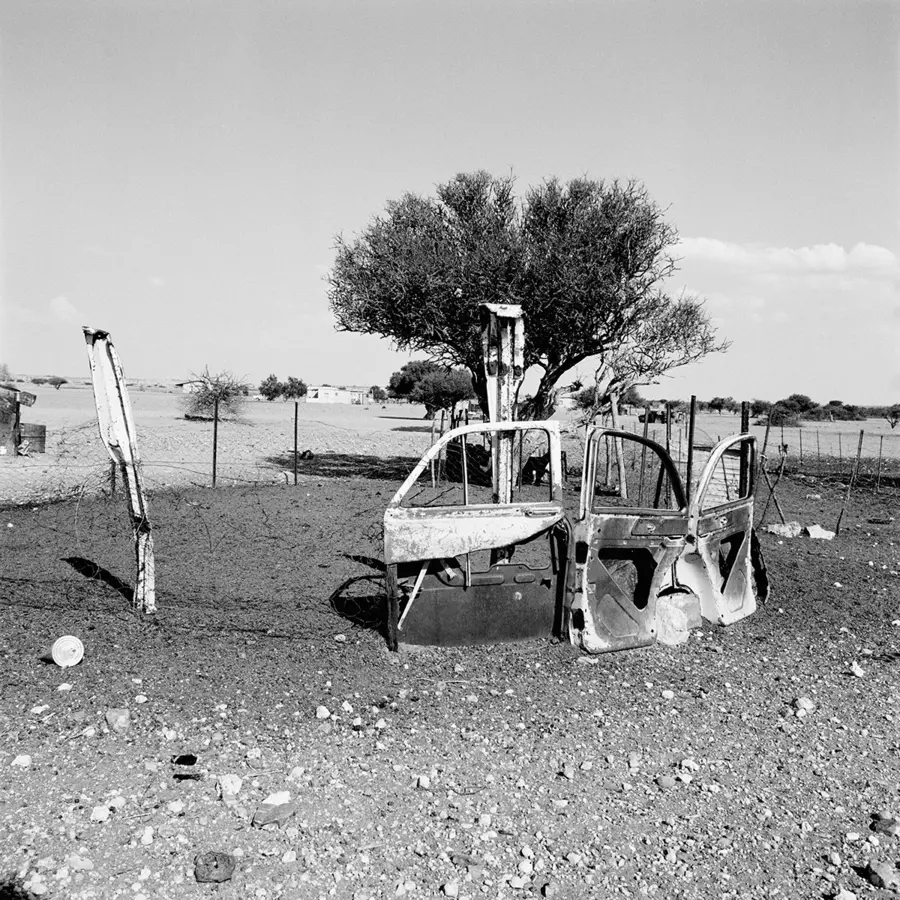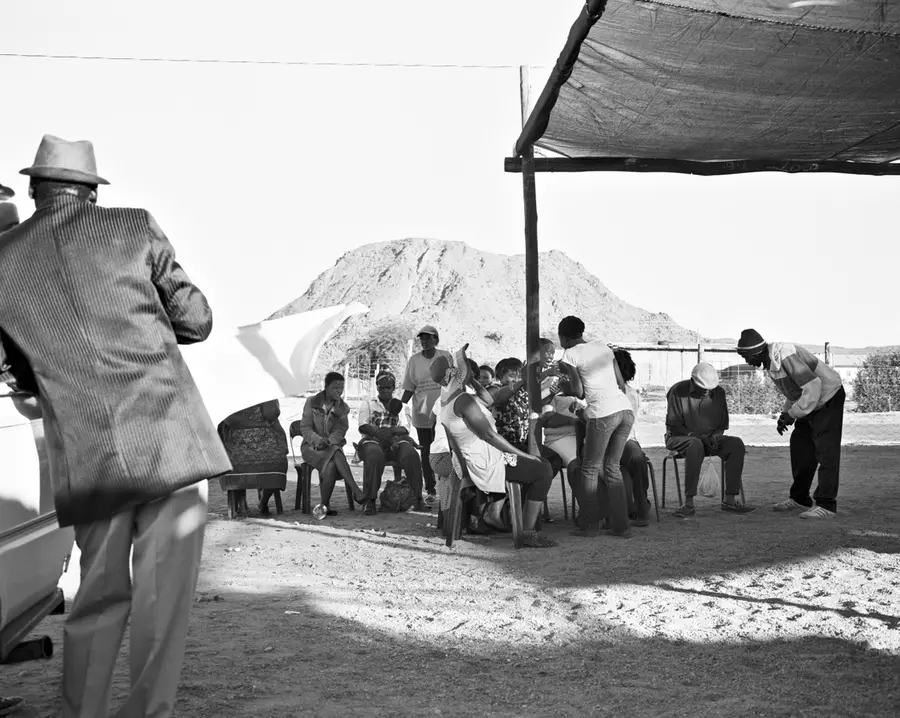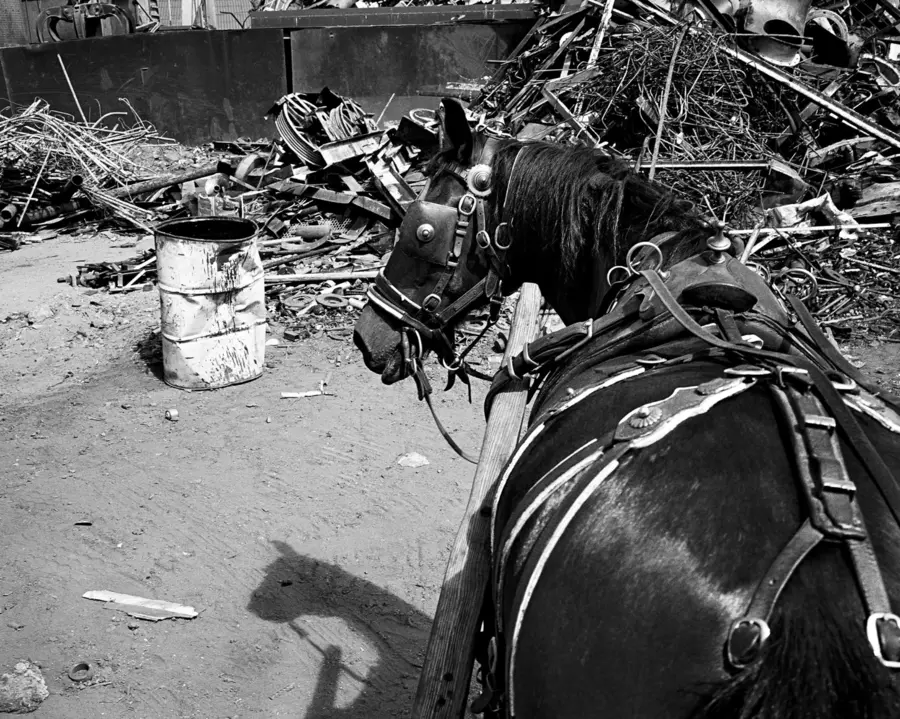Where Do the Myths Lie?
Ikechukwu Casmir Onyewuenyi considers the imaginary in Jo Ractliffe's landscapes of conflict
Full ArticleStepping into one of Ractliffe’s photographs is not unlike entering the uncanny universe of Pedro Páramo: harsh landscapes populated by disquieting shadows, places where time seems to have abandoned a linear trajectory, where the dead and the living inadvertently cross paths.
– Daniela Montelongo, from the essay 'On the Road to Paramus: A Tale of Two Donkeys', DBPFP22 Catalogue
For more than three decades, South African photographer Jo Ractliffe has trained her lens on the charged landscape of her homeland. Photographs 1980s - now is an extensive monograph, which includes significant photo-essays, early works and newly published images, richly contextualised by literary references and testimonies from a diverse range of writers, curators and thinkers. Presented chronologically, and introduced by the artist’s direct, almost diaristic, texts, Ractliffe’s images bear witness to the complexities of a country scarified by the violence of Apartheid, as well as the aftermath of civil war in neighbouring Angola. While Ractliffe is often acknowledged as one of South Africa’s foremost social photographers, her stripped back, often stark images do not sit typically within the social documentary genre. Ractliffe is drawn to quiet poetics, not direct political address, lyricism rather than invective. From decommissioned military outposts, to makeshift dwellings stalked by stray dogs, her subject matter is conveyed through a distinctive visual language marked by desolation and absence. But neither are these images silent or empty, rather they convey these sites of massacre, forced removal and violence with a mute intensity. Though black-and-white images predominate, there are also important forays into colour photography and experiments with photomontage and video. Photographs 1980s - now allows us to trace some of the key tropes and stylistic threads which run signature like through her work. These include such favoured techniques as presenting images in ‘filmstrip’-like sequences, or photographing with plastic and toy cameras, as a way of adding to Ractliffe’s singular way of capturing life -or lack of it – on the open road.
Culled from her recent monograph, Photographs 1980s – Now, it is the work that most repays close attention, her quiet observational approach characterised by subtle visual rhythms and echoes that speak of a deep and patient engagement with the land, its people and its ghosts.
Sean O’Hagan - The Guardian
When did your relationship to photography begin, and what qualities continue to draw you to it?
I came to photography quite late. When I was in high school in the 1970s, being an artist meant being a painter or sculptor; photography, if anything, was a ‘boy’s hobby’ – it wasn’t even an option when I first started art school. So I ended up painting – and badly and unhappily at that. In 1980 I bought a camera – an old, second-hand Nikkormat, I still have it. It changed everything; it was like a little light went on inside my head. Funny how things make sense in retrospect: my matric art project was on photography; I produced a whole book of pictures, printed in the darkroom of a boy who lived down the road from me. So it was there, waiting, all along! It’s hard to articulate precisely what photography holds for me. The crux of it, I think, is its trace of the real, coupled with the fact that things are not simply how they appear. I’m not sure if this makes sense, but it has something to do with the capacity of the photograph to anchor abstraction – whilst retaining its causal link to ‘reality’. And it’s the rub between those two contradictory things that excites and frustrates me – and it’s as challenging now as when I first started working. The other aspect has to do with the fact that my work mostly takes me out into the landscape, and many of the places I photograph involve long drives to get there. Actually, I think driving was already in me, even before I picked up a camera. When I was still a child, my father managed a brickworks up the West Coast – roughly an hour’s drive up the West Coast. I would go to work with him on weekends and holidays – always leaving the early morning and driving home late at night, in the dark. My first pictures were a return to that landscape – long, solitary drives up the West Coast. So photography and driving felt connected – inseparable even. Something about time and distance seemed necessary when entering the spaces I was photographing. But more than that, I think my very sense of seeing was formed during those early trips with my father, the measure of things framed by the car window as we drove through the countryside.
It’s hard to articulate precisely what photography holds for me. The crux of it, I think, is its trace of the real, coupled with the fact that things are not simply how they appear.
– Jo Ractliffe
What are your key influences and inspirations. Are there particular things that have shaped you creatively?
When I started photographing there wasn’t much access to the work of international photographers – South Africa was quite isolated during that time and specialist books were hard to come by. In 1982, returning from a trip overseas, my father brought home a book called World Photography. It introduced me to many of the greats like Robert Frank, Joseph Koudelka, Bill Brandt, Henri Cartier-Bresson and, importantly, Manuel Álvarez Bravo – all men! But that book was critical in shaping my approach to photography. Reading what the photographers had to say about their work, it occurred to me that the separations between genres or conventions or approaches – whatever terms or classifications you might use – were not fixed. Things overlapped and so you could be political and poetic and expressive at the same time. This was quite unusual in South Africa where photography’s primary role was to expose the injustices of the apartheid government and there were fairly clearly delineated codes and conventions about how people worked. There are others: Richard Misrach’s work, particularly the Desert Cantos (1987), the testing sites in the desert; something of the sparse, pared-down quality in his photographs really interested me early on. And the photomontages of John Heartfield and film-still composites of John Baldessari. Then of course, there are filmmakers whose attitude to space and landscape and light were really influential: Wim Wenders, Terrence Malick, Sergio Leone, Akira Kurosawa and also cinematographer, Gabriel Figueroa, whose work I only ‘discovered’ about fifteen years ago. And lastly, the incomparable Graciela Iturbide whose work is simply beyond words. Much of my thinking and seeing, though, connects with what I read – literature, poetry, even songs have helped me articulate the thoughts, ideas and images of my internal world. It might have something to do with the shift in medium; words activate my imagination differently from images and while I’m a terrible writer and I always feel locked down by words, the opposite happens when I read. In almost all my work, I can see where someone’s writing has entered in, from Ryszard Kapuscinski’s dogs, first appearing in Nadir (1986-8) and sending me on a search in Luanda 20 years later, to Emmanual Iduma’s excerpt on the sea in A Stranger’s Pose (2018) that brought together all the disparate elements of Signs of Life (2019), even the title, Guess who loves you (1997), which came from a Garfield mug! In the Angola work, the phrase ‘no stockades can keep the midnight out’ came from a Norman MacCaig poem, Hotel Room, 12th Floor (1968) that I had written out in a notebook 15 years previously. And when struggling to articulate what I was looking for in the battlefields of Angola, I found, in Susan Sontag’s On Photography (1977), the term, ‘negative epiphany’, to describe her experience first seeing the photographs of the concentration camps. That propelled a question about how to work in a landscape of absence and silence.
How do you go about making work – what is your process?
I’ve pretty much always worked outside and in the landscape. I try to avoid the word ‘landscape’ because it’s such a difficult term – after all landscape is less about space or place than it is about a view – but I’ve struggled to find an appropriate alternative. But I think of it less of a ‘subject’, or genre, than the medium through which I can explore questions of violence, conflict and memory – in particular, the ways in which past violence is manifest in the space of the present. My general tendency is to work in response to an idea or situation rather than predetermining things, so most of my work starts in a fairly open-ended way, often prompted by a question or experience, or sometimes something I’ve read. So to elaborate on comments in the previous question about this, for example, when I first went to Angola, I was propelled by two things: one was Ryszard Kapuściński’s account, in his book Another Day of Life (1987) of the dogs in Luanda, abandoned when the Portuguese fled. He witnesses them leaving the city and imagines various journeys they might take, which armies they may have encountered. I had the idea to go in ‘search of Kapuściński’s lost dogs’. The other prompt was something Susan Sontag wrote about in On Photography (1977) where she discusses her response to photographs from the Bergen-Belsen camps. She says that after seeing those photographs something was forever changed in her. She uses the phrase, “negative epiphany.” I was deeply intrigued by that comment and wondered how that would translate or resonate in a space where violence and trauma have long passed, with even their residues no longer apparent. So I like to work with indeterminacy; a space where I can photograph intuitively, where I can be responsive and open to the play between contingency and intention. I don’t pre-empt things or plan much in advance; most of my research is unfolding while I’m working, and even where there is knowledge-based research to be done, lived experience is very different on the ground and this often directs the work. With a few exceptions, such as when I was travelling through Angola with military veterans when working on As Terras do Fim do Mundo, I work alone. I’m a slow worker; I make a number of visits to the places over an extended period, and so the work develops over time through a process of accrual, as I get to know the places I’m photographing.
Do you have a favourite context in which to present your images? Photobook, Exhibition, Online – they all offer such different experiences…
I’ve always wanted to take photographs off the wall – literally. I’m interested in thinking about space as a medium, whether it’s the space of the gallery, outdoors in the city or landscape, or even the book. Recently, since the Angola series, I’ve been making books alongside my exhibitions, but exhibitions are still the first realisation of a body of work – and the ways in which the images activate each other in physical space will determine the structure, design and layout of the book. Reshooting Diana (1995) was my first ‘off-the-wall’ exhibition. ‘Diana’ here refers to the plastic camera I used for the work. There’s a long story about how I came to work with this camera but there were two primary notions behind the rationale for the installation. Firstly, the murky, out-of-focus snapshot nature of the resultant images got me thinking about family snaps and home movies – other kinds of documents alongside the empiricism of social documentary. Which also got me thinking about the fragment, something manifestly unhinged from its context. The installation contained fifty silver gelatin photographs (each 50 x 50cm), suspended back-to-back between sheets of glass in five rows, each a metre apart. A second work, A Sunny Day, comprised five postcard racks, each containing twelve photographic postcards. Viewers were invited to take a postcard away with them – a souvenir, and literally a piece of the exhibition. Individually, the postcards comprised cut-ups of duplicate prints of the photographs on show – a fragment of road or sky, a detail of a building or sign. Collectively, in the racks, they made up a relatively coherent image, but one that constantly shifted as new postcards replaced those that were taken.
Probably the most elaborate, but minimal project was End of Time (1996/9), an exhibition which grew out of an incident while driving along the national road between Johannesburg and Cape Town. I was busy making a photographic inventory of the road: one image every hundred kilometres. Roughly halfway between the two cities, I came upon three donkeys lying alongside the road. They had been shot. This brought my conceptual exercise into sharp reality. I mounted the exhibition in the Karoo village of Nieu-Bethesda; and getting there also involved an actual journey – roughly eight hours of driving through the Karoo, depending on your starting point. I wanted to interrupt the journey – as mine had been – so I installed three billboards along the national road near the town, so that passing travellers would encounter the giant image of a donkey looking out from that landscape. In the gallery, that journey was reflected back via the images on show: a long strip of 28 photographs of the road between Johannesburg and Cape Town and back, taken at 100-kilometre intervals. On the other side was a large, almost life size portrait of one of the dead donkeys.
Can you tell us the story behind any particular images from your nominated work?
We took this journey because David (Goldblatt) was on a mission to find Bute Asbestos Mine. From Kuruman we travelled north, passing through Heuningvlei – a dry ghost of a pan flanking an old mining village that had once boasted swimming pools and tennis courts and picnic areas, now all of it a desolation. There we left the chalky white dirt road and headed into the landscape. It was hot, very still and quiet – each sharp clunk of a rock hitting the car’s undercarriage magnified in the silence. I had my copy of T. V. Bulpin’s Discovering Southern Africa with me, searching out bits of information – geological formations, early expeditions and mining explorations – as if these would activate something out there, deliver me from the sameness of it all, but whenever I looked through the window, it was just shiny brown rock, glinting with the blue of asbestos. Sometimes David would point to a mound of rocks, or a shallow pit in the ground; looking closer these might reveal the remains of an open cast mine or an adit. And then we would discover other things; an old enamel mug or a tin bath, traces of past labour. So we proceeded.
Then suddenly, in the middle of a clearing there was a well. We stopped, and it was as if someone released the ‘pause’ button and the world came back into motion. Two women sat under a tree doing their washing, blankets draped over the bushes nearby like little bright tents. At a distance, three men sat smoking, their dogs stretched out flat and limp around them. Everywhere the air was dense with the flickering of white butterflies. A group of donkeys, all hobbled, came hopping to the well to drink, later a white cow and her calf, then some goats. And into all this new noisy activity, through a cloud of dust, a horseman galloped up to the well. He was wearing huge teardrop sunglasses. Seeing me, he shouted ‘Hey sister!’, and with arms extended like an announcing angel, he slid off his horse and held the pose for me to photograph.
Pomfret was not on our maps. Once an asbestos mine, then an army barrack, it now houses Angolans who had fought in the war. Uniformed guards control the gate and you have to sign in to gain entry. It is a sullen place, unescaped from its past. There is a school and a clinic, but otherwise nothing to indicate that a few thousand people – so we were told – are living there. It has a mood I remember from childhood – listless Sundays with nothing to do and nowhere to go. Buildings stand empty in streets lined with gum trees, the church is veiled with camouflage netting, and towering over the landscape, grey and silent like the reminder of disaster not yet over, is the mill. One of the mineshafts has filled with water and local children swim in there – asbestos and all. David photographed them, their bodies luminous in the dim watery light. An old man came to do his washing; he was thin, alarmed looking, his clothes so worn as to be almost transparent. He put down his bucket and sat rolling a cigarette from old butts and newspaper. Then he sat and smoked. For a time, we sat at the entrance to the shaft, watching him and waiting, him unconcerned with our presence and what we might be doing there.
That was Christmas day in 2002. We spent the evening in the Vryburg Hotel, watching young boys in trucks drive up and down the street, repeatedly, whooping into the dark night. Nearly a decade later I retraced our journey, this time to photograph the remains of the military base established there in 1987 after South African troops withdrew from Angola.
A Further Reading List From Jo Ractliffe
Writings, Books and Films (films noted with Directors):
Chimamanda Ngozi Adiche. Half of a Yellow Sun. New York, Knopf, 2006
J M Coetzee. Waiting for the Barbarians. Penguin, 1982.
Joan Didion. The Year of Magical Thinking. New York, Knopf Publishing, 2005
Bob Dylan Nobel Prize Acceptance Speech
Robert Frank’s Guggenheim Application
Pumla Gobodo-Madikizela. A Human Being Died That Night. Southern Africa: David Philip, 2002.
Russell Hoban. Riddley Walker. London: Jonathan Cape, 1980.
Emmanuel Iduma. A Stranger’s Pose. Nigeria: Cassava Republic Press, 2018.
Alejandro G. Inarritu (dir). Amores Perros, 2000.
Jim Jarmusch (dir). Dead Man, 1995.
Ryszard Kapuściński, Another Day Of Life, Harcourt Brace Jovanovich, New York, 1987.
Jack Kerouac. On the Road. New York: Viking Press, 1957.
Emir Kusturica (dir). Time of the Gypsies, 1988.
Sergio Leone (dir). 1968. Once Upon a Time in the West, 1968.
Terrence Malick (dir). Badlands, 1973.
Michael Matthews (dir) Five Fingers for Marseilles, 2018.
Pablo Neruda. Selected Poems. London: Jonathan Cape, 1970.
Michael Ondaatje. In the skin of a Lion. London: Pan Books, 1988.
Erich Maria Remarque, All Quiet on the Western Front, United Kingdom: Little, Brown and Company, 1928.
Sam Shepard. Motel Chronicles & Hawk Moon. London, Faber and Faber, 1985.
Wenders, Wim (dir). The State of Things, 1982.
Wenders, Wim. The Logic of Images: Essays and Conversations. London: Faber and Faber, 1991.
Ikechukwu Casmir Onyewuenyi considers the imaginary in Jo Ractliffe's landscapes of conflict
Full Article"For Ractliffe, human behaviour seems as mysterious as it is violent and destructive" – Eugenie Shinkle on the work of Jo Ractliffe for C4 Journal
Full ArticleRead Sunil Shah's reflections on 'Photographs 1980s-now' for American Suburb X
Full ArticleNicole Acheampong for Aperture on the way 'Photographs 1980s-now' demonstrates how words and pictures bring historical memory into sharp relief.
Full ArticleJo Ractliffe in conversation with Sandrine Colard-De Bock in 2015
Jo Ractliffe in conversation with Okwui Enwezor in 2008
A conversation between Jo Jo Ractliffe and Artur Walther, marking the launch of 'Photographs, 1980s - now'
Jo Ractliffe first developed her photographic practice in the 1980s. This was a tumultuous time for South Africa, marked by an escalation in state violence as anti-apartheid resistance mobilised against the government. Her work is born from and, almost always, shaped by the trauma of apartheid. And yet her images eschew literal representations of violence or the numbingly familiar markers of brutality. Instead of direct political address, or what Okwui Enwezor called ‘documentary literalism’, Ractliffe is drawn to quiet poetics – ‘to allegory and aftermath’ – to address themes of conflict and displacement; memory and erasure.(1) And so across landscapes, and bodies of work, we encounter a visual topography marked by desolation and absence. The human figure is largely absent; but ground that appears barren is stalked by stray animals and, moreover, by history. An innocuous farmhouse in the countryside west of Pretoria is revealed to be the notorious headquarters of a covert hit-squad, infamous for its barbarism; sparse tracts of land, makeshift dwellings and forest scrub are sites of landmines, of massacres and of forced removal. Ractliffe approaches her subject indirectly and after-the-fact, revealing her suspicion about the camera’s ability to convey anything but a contingent truth ‘I’m interested in the idea of the photograph as a complex yet open-ended space where meanings aren’t fixed but fluid,’ Ractliffe relates. ‘Questioning the constructs of photographic representation is a concern that underpins every aspect of my practice’. (2)
In 2015 Ractliffe sustained a spinal cord injury, restricting her capacity to work in the landscape. Consequently, she has been revisiting her early interest in juxtaposition and montage. Combining new photographs with previously unpublished images from her archive, Ractliffe’s recent exhibitions, Everything is Everything (2017), Hay tiempo,no hay tiempo (2018) and Signs of Life (2019), have explored the sometimes unexpected associations and meanings that emerge from the assemblage of disparate images which cut across time and place.
Ractliffe has exhibited at many international museums and arts venues. In 2021 Jo Ractliffe: Drives, the first survey of the photographer’s work in the United States, took place at the Art Institute of Chicago. She has published many photo books including Signs of Life (2019) Everything is Everything (2017) and The Borderlands (2015). Since 1985, Ractliffe has taught within formal and informal contexts including Wits University, Johannesburg, the Market Photo Workshop, Johannesburg, and the Salzburg Summer Academy.
1. Okwui Enwezor, ‘Exodus of the Dogs’, Jo Ractliffe, Terreno Ocupado, Warren Siebrits Modern & Contemporary Art, Johannesburg, 2008
2. Jo Ractliffe, interviewed by Hannah Abel-Hirsch, British Journal of Photography, 6 August 2021



